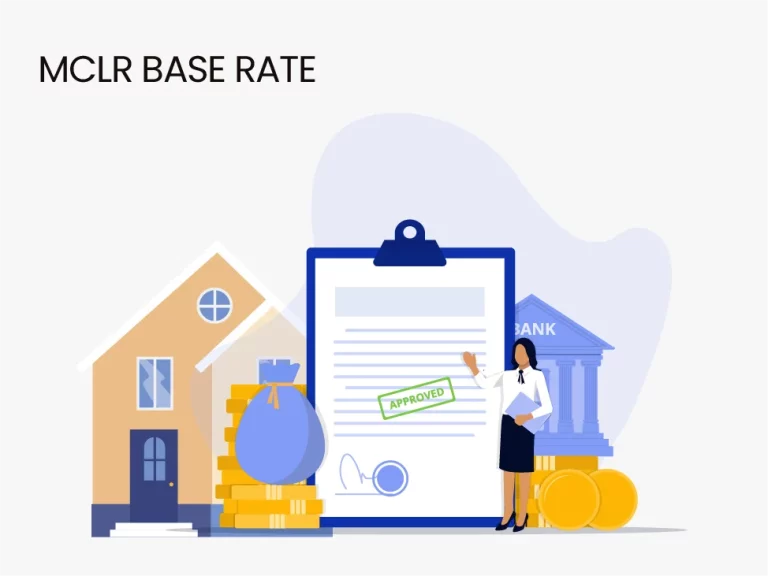Yamini Pahwa
Last Updated on 28th August 2025

Yamini Pahwa
Last Updated on 28th August 2025
Home loans, car loans, and personal loans all depend on one crucial factor—the interest rate set by banks. Behind every loan, there’s a benchmark that determines how much borrowers pay and how banks earn. Two important terms you will often come across are MCLR (Marginal Cost of Funds Based Lending Rate) and the Base Rate.
If you are confused about how they work, how they affect your EMI, and what the current base rate in India is, this guide is for you. We’ll break everything down in simple language and provide step-by-step clarity.
Table of Contents
The base rate is the minimum interest rate that a bank can charge its customers. It was introduced by the Reserve Bank of India (RBI) in July 2010 as a replacement for the earlier Benchmark Prime Lending Rate (BPLR) system. The base rate RBI mechanism aimed to bring more transparency to lending and ensure that borrowers received fairer rates, rather than banks giving arbitrary concessions to large corporates.
In other words, no bank could lend below its bank base rate, except for a few exceptions like loans to staff or loans under special government schemes.
In April 2016, the RBI introduced the Marginal Cost of Funds-Based Lending Rate (MCLR) as the new benchmark for lending rates. The reason was simple – the base rate in India was becoming outdated. Banks were not passing on the RBI’s rate cuts to borrowers quickly. To address this, the RBI introduced the MCLR, which links loan rates more closely to the cost of funds, making them more responsive to monetary policy changes.
To understand the shift, let’s look at the differences
|
Feature |
Base Rate |
MCLR |
|
Introduced |
2010 |
2016 |
|
Calculation Basis |
Average cost of funds |
Marginal cost of funds |
|
Transparency |
Moderate |
Higher |
|
Transmission of RBI Policy |
Slow |
Faster |
|
Flexibility |
Limited |
Multiple tenures (overnight, 1 month, 3 months, etc.) |
The base rate RBI introduced was an improvement over BPLR, but it still lagged when RBI changed repo rates. Banks often delayed passing on benefits. With MCLR, changes in the present bank rate are supposed to reflect more quickly in loan rates.
The bank base rate was calculated based on several factors:
So, if you took a loan in 2012, your EMI depended on the current base rate in India declared by your bank. If the base rate today were 9.5%, you couldn’t get a loan below that, no matter your credit score.
Suggested read: MCLR Based Home Loans
Even though RBI shifted to MCLR in 2016 and later to external benchmarks like the repo rate, the base rate still applies to old loans that were taken before April 2016. Borrowers who haven’t switched continue paying interest linked to the bank base rate.
To make things easier, here’s a side-by-side comparison:
|
Feature |
Base Rate |
MCLR |
Repo-Linked Lending Rate (RLLR) |
|
Who decides? |
Bank, guided by the RBI |
Bank, based on marginal cost |
Directly linked to the RBI repo rate |
|
Introduction |
2010 |
2016 |
2019 |
|
Transparency |
Moderate |
High |
Highest |
|
Reflects repo cuts quickly? |
No |
Partially |
Yes |
|
Borrower Benefit |
Limited |
Better |
Best |
This shows that while the base rate in India was a step forward in its time, the system has evolved further for better borrower benefits.
For borrowers who shifted to MCLR after 2016, the impact was relatively positive:
If you have an old loan and want to know your base rate now, you can:
If you are still on the base rate in India, here’s what you need to consider:
Example: If your outstanding loan is ₹20 lakh with 15 years left, and your bank base rate is 9.25%, while repo-linked is 8.5%, switching can save you several lakhs in interest.
RBI does not set the base rate today or the MCLR directly. Instead, it provides a framework. Each bank decides its rates based on the formula provided by the RBI. However, the RBI does announce the present bank rate, which influences overall lending rates.
The base rate RBI introduced was a step toward uniformity, but MCLR and repo-linked rates brought borrowers even closer to the central bank’s policies.
The journey from base rate in India to MCLR and finally to repo-linked rates shows how India’s banking system has evolved to benefit borrowers. While the bank base rate served as an important reform in 2010, it was eventually replaced for better efficiency and transparency.
If you still have a loan under the base rate RBI framework, it’s time to explore switching. Always check the current base rate in India against MCLR and repo-linked rates. By doing so, you can ensure you’re not overpaying on your EMIs.
Remember, the base rate now may not give you the best deal. Staying informed about the base rate today and the alternatives is the smartest financial step you can take.
It is the Marginal Cost of Funds-Based Lending Rate, introduced in 2016 by RBI. It’s the minimum rate at which banks can lend, replacing the earlier base rate RBI system.
It is based on the marginal cost of funds, operating expenses, negative carry on CRR, and a tenor premium for long-term loans.
The base rate used the average cost of funds and was less transparent. MCLR uses the marginal cost of funds, making it more responsive to RBI policy changes.
Banks review and reset MCLR every month, but your loan EMI may change only on the reset date (like every 6 or 12 months).
Home loans linked to MCLR adjust with RBI’s repo changes faster than base rate loans, which means borrowers usually get lower EMIs compared to the current base rate in India.